Biology
(
Inglês
)
fornecido por Arkive
The foxglove is a biennial plant, but more rarely occurs as a perennial. The flowers are present from June to September (5) and are pollinated by bumble-bees (2). Plants produce prolific amounts of seed, and have a persistent seed bank; features which help to maintain the range of this species (3).
Although toxic, the foxglove has been widely used in folk medicine as a cure for sore throats, as compresses for bruising and ulcers, and as a diuretic; it was, however, often fatal. The 18th Century Scottish physician William Withering made the first scientific investigation into the use of the plant. This study marked the development of modern pharmacology, and its move away from herbal medicine. He discovered that the plant contained a powerful cardio-active agent, which slowed and strengthened the heart rate, and stimulated the kidneys to clear excess fluid from the body (4). The therapeutic dose was however, very close to a lethal dose, and Withering recommended the use of repeated very small, carefully measured amounts until a therapeutic effect was attained (6). The active agents in foxglove, known as digitoxin and digoxin are still used in modern medicine to control heart rate (4). During the Second World War, foxglove leaves were collected by County Herb Committees, in order to make these drugs (4).
Conservation
(
Inglês
)
fornecido por Arkive
Not relevant.
Description
(
Inglês
)
fornecido por Arkive
The foxglove is a familiar tall herb that produces 20-80 nodding flowers on a long spike, known as a raceme (2). The tube-like flowers are pinkish-purple in colour, with an area of white inside the tube, which features darker purple spots and a few hairs. More rarely, white flowers may appear (2). The greyish stem is woolly, and the green, oval or lance-shaped leaves have downy upper surfaces, but are woolly below (2). The common name derives from the Anglo-Saxon 'foxes glofa' meaning foxes gloves, and refers to the tubular flowers, which are suggestive of the gloves of a small animal. The flowers were also known as 'witches' thimbles' by Medieval herbalists (4).
Habitat
(
Inglês
)
fornecido por Arkive
This species thrives in acidic soils in a range of habitats including open woods, woodland clearings, on moorland and heath margins, hedge banks, sea-cliffs, waste land, rocky mountain slopes and hedgebanks. It is common in disturbed sites, or on burnt ground (3).
Range
(
Inglês
)
fornecido por Arkive
Very widespread throughout Britain, and common as a garden plant; garden escapes have spread the species widely beyond its native range (3). It also occurs in western and south western Europe (2).
Status
(
Inglês
)
fornecido por Arkive
Widespread and common (3).
Threats
(
Inglês
)
fornecido por Arkive
This species is not threatened.

